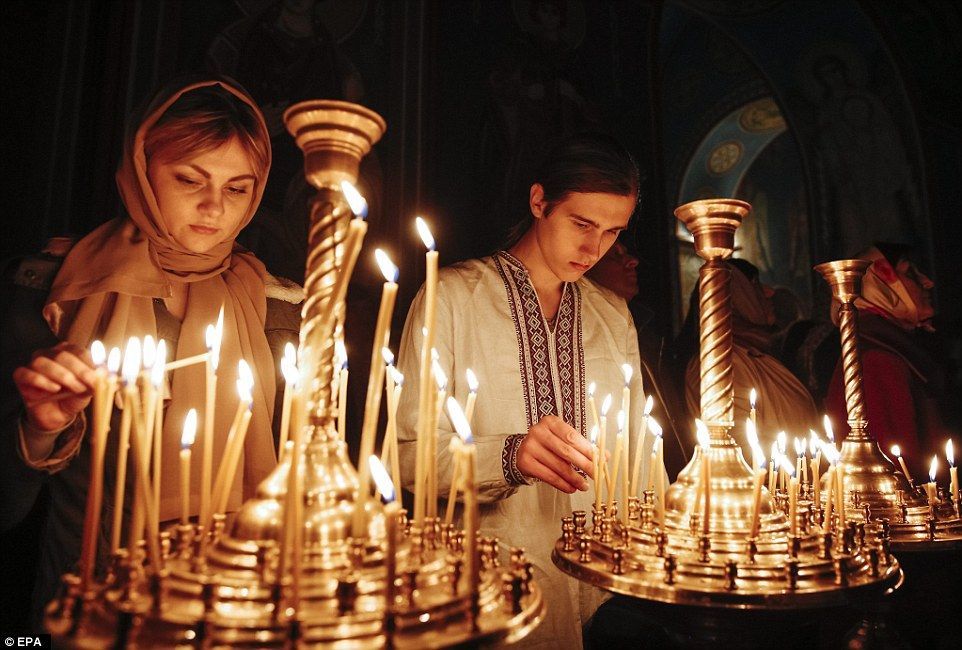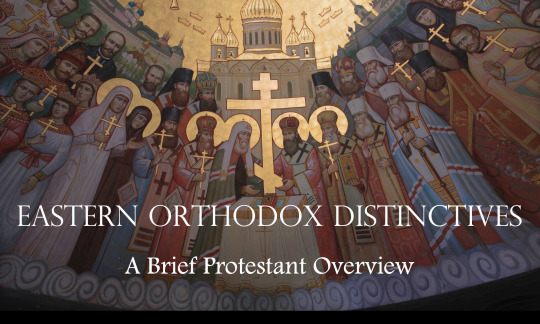 What is the Eastern Orthodox faith all about, and is it biblical? I remember a few years back when Hank Hanegraaf, the nationally syndicated host of the radio talk show program Bible Answer Man, was fired from his radio network after his conversion to Eastern Orthodoxy.
What is the Eastern Orthodox faith all about, and is it biblical? I remember a few years back when Hank Hanegraaf, the nationally syndicated host of the radio talk show program Bible Answer Man, was fired from his radio network after his conversion to Eastern Orthodoxy.
When we examine what he converted to, some red flags pop up. But there is much more to this religion that lies beneath its surface; the uneasy niggling of the soul that many folks can’t quite put their fingers on, but know deep down that their concerns are legitimate.
I recently came across an excellent article outlining the doctrinal distinctives of what the EO faith believes and teaches. You can find it on the pilgrimdrewbert blog. The author has generously given me permission to share the article here, and I am grateful to be able to do that for our readers who have questions:
Eastern Orthodox Distinctives: A Brief Protestant Overview
As someone who has worked with Ex-Charismatics seeking to rebuild their faith from the wreckage inflicted by the Hyper-Charismatic movement, I’ve witnessed quite a few people leave the New Apostolic Reformation only to convert to the Eastern Orthodox faith. I must admit, at the time, I was unable to dialogue with them because I was mostly ignorant of what the Eastern Church teaches.
Since then, I’ve listened to hours of primary sources, letting EO priests explain what they believe and why they believe it. Studying it has only further cemented my foundation as a Protestant.
I believe it is important to be aware of what is taught because most Westerners are unprepared for the arguments that come from the Eastern Church. Especially for those who are fleeing the pop culture theology of mainstream Evangelicalism, Eastern Orthodoxy can be very appealing because it is strongly tethered to history and doesn’t change with the cultural currents of the day.
People are craving stability and substance. EO definitely has stability due to its culture of honoring tradition. The sacred feel of the music and ornate images can be mesmerizing. When you walk into an EO church, it can seem like you are crossing the threshold into another world. Every chant of the liturgy, every stitch in the priestly vestments, every icon and incense burner….all of it is rooted in a tradition that has developed over centuries and has stood the test of time. The beautiful sights and sounds are truly captivating.

However, we must be like the noble Christians at Berea and carefully examine the claims of the EO church, as they believe themselves to possess the only true Christianity. The following is, by no means, an exhaustive list of EO beliefs. Rather, it provides a few highlights so that Protestants can BEGIN to familiarize themselves with the teachings and practices. This is also not intended to be a response to these doctrines. Take responsibility for your own faith and compare the following items to God’s Word.
The Atonement: The death of Christ on the cross has nothing to do with the forgiveness of sins in EO theology. Rather, Jesus died so that he could free the righteous dead from Hades, not to atone for sins. God forgives sins simply because He is a forgiving God, not because of the cross. The cross was a victory over death and a call to take up your own cross. Their Perspective HERE and HERE

Sola Fide: EO rejects the Gospel essential of “Faith Alone”. They do not believe in justification by faith or imputed righteousness. Salvation is viewed as a progressive healing of the soul over the course of time…an ongoing restoration of the “Nous”, which refers to the spiritual aspect of our being that was created to have union with God and was damaged in the Fall of Man. Salvation is seen as a journey. This salvific process cannot be done outside of being in good standing in the Orthodox Church. In addition to church participation, parishioners are expected to engage in fasting, meditations, and repetitive prayers to assist the soul in climbing the ladder to Christ. Yes, it is taught that the salvation journey resembles climbing a ladder to get to Jesus. 👇🏼 The Ladder of Divine Ascent
Sola Scriptura: They also express contempt for the Protestant doctrine of “Scripture Alone”. They teach that there was no New Testament for the first 200 years of the church. While yes, the canon was not finalized till later, the early church was established on the apostles’ teachings which would later be canonized as the New Testament. The authority was always the Old and New Testament Scriptures.

Orthodox priests teach that the authority of the Faith is found in the patriarchs because they make up the authority structure that Christ established. This view of authority allows them to hold to beliefs that are outside of Scripture. They hold up teachings of Orthodox saints as possessing the same level of authority as the New Testament, and the NT is viewed as just another part of the holy tradition. Truth is to be found in the dogmas and traditions passed down through the centuries by the Orthodox fathers and it is believed that all these developments have been directly guided by the Holy Spirit. They consider themselves members of the one Church established by Christ and all other denominations have therefore apostatized from THE Church. To not be Eastern Orthodox is to be a schismatic…to not participate in the Christianity that Jesus established.
Their Perspective HERE

Mysticism: Theology and mystical experience are not at odds in the EO faith. They believe God often calls individuals into the Orthodox Faith through mystical experience. Whether that is an experience of the beauty of the music or the beauty of the icons (images) of the church, God is calling you. Not through the power of the preached Gospel, but through subjective experience. Asceticism is valued as a path to encountering God. The most pious are those who separate themselves completely from the world in monasteries to encounter God in silence.
Prayer: The truly spiritual will devote themselves to the practice of Hesychasm, a form of prayer developed by monks on the holy Mount Athos. In this practice, you focus on your breath in perfect stillness as you repeat a mantra called “The Jesus Prayer”.
From Wiki 👇🏼
“According to the standard ascetic formulation of this process, there are three stages: Katharsis (κάθαρσις) or purification, Theoria (θεωρία) or illumination, and Theosis (θέωσις) or deification (also referred to as union with God).” This Jesus Prayer mantra is as follows, “Lord Jesus Christ, son of God, have mercy on me, the sinner.”

Endless repetition of this prayer brings healing to the Nous, the part of the person that is made to have union with God. The constant practice is designed to keep temptation away and focus on the experience of God’s light within. While the words of the Jesus prayer are Biblical and beautiful, the practice itself is seeking to be a vehicle for mystical enlightenment rather than focusing on the Gospel content of the words.
Hell is viewed as God pouring out His love on the wicked, not His wrath. It’s just that the wicked hate God so they cannot receive His overpowering love and it consumes them. Hell is understood, not as a place, but as a state of being. Heaven is also a state of being. Both experiences are relative to the person’s relationship to God. God reveals Himself to all people in the end and their state of being determines whether that is an experience of heaven or hell.
Prayer for the dead is a regular practice…once your soul leaves your body in EO thinking, you begin a new phase of your spiritual journey. Your guardian angel comes to comfort and help you on your way to paradise. Demons also come to try to hinder your journey, and it is believed some poor souls can be taken away by the demons to destruction. So, prayer must be made for the dead. Those who die in a more righteous state will have little problem on their post-death journey. But those who die weighed down by sins and passions will be easy prey for the demons. This journey is seen as a process of purification. But we know the truth…”It is appointed for man to die once, and after that comes judgement.” Heb 9:27 There is no post-death journey to God. Our eternity is determined in this life by God’s grace and His raising us to new life in Christ. Their perspective HERE and HERE

Prayers to the saints: Part of Orthodox liturgy is to pray to ancient saints, asking them to intercede on your behalf. Mary is also asked to intercede. The entire Book of Hebrews refutes this practice. Jesus alone is our intercessor between us and the Father. His intercession is sufficient because of Who He is and what He’s done for us in His life, death, and resurrection.
Veneration of Icons: You’ll notice people in Orthodox worship, bowing to or kissing images called “icons”. These icons are images of Jesus, church fathers, saints, and the virgin Mary. Some icons contain scenes from Scripture or Church History and are designed to tell a story. This is not seen by them as worshiping the images but the icons are seen as windows into the spiritual realm and assist in worship of the true God. You are meant to encounter God in the beauty of the iconography and the pageantry of the divine service. For an excellent video addressing the issue of venerating images, follow this link to Gavin Ortlund’s teaching HERE. For a comprehensive EO perspective on Icons, I found this Orthodox documentary very educational (strong discernment required)

Orthodox priests cannot marry, but if you were already married, you can become a priest. So, if a man becomes a priest while he is single, then he cannot marry as long as he remains a priest.
Monks and nuns are viewed as those who are most purely devoted to God. For a glimpse into the life of EO monks and nuns, here are two documentaries….HERE and HERE
Anti-Schism: They claim to be the one true church because they never divided into denominations, but the Roman church split from them and Protestants split from the Roman church. They claim that this shows the gates of hell have not prevailed over the church. This however is not what makes a church a church. Faithfulness to Christ and His Gospel is what keeps the candlestick in place and the Eastern Orthodox Church teaches a gospel that is contrary to the apostles’ doctrine.
Converting to Orthodoxy can be a rigorous process. Depending on how long your particular priest wants to drag it out, your catechumen process could take many months or even a couple years. This is when you are formally learning the dogmas and traditions of the EO faith. After this process, you are baptized and undergo Charismation (anointed to receive the Holy Spirit). Then you are allowed to take communion. Once you are fully “in”, you get to choose your patron Saint to whom you will pray regularly. At this point, you are also told that you receive your very own guardian angel.

What is the Gospel according to Eastern Orthodoxy? They focus on the resurrection of Christ from the dead. By dying on the cross, Jesus emptied Hades of the souls that trust in God. Those that seek union with God through the EO Church can now attain that union one day because of His resurrection. The forgiveness of sins is not the focus of this gospel, but rather the fact that Jesus took on human flesh to rescue us from the certainty of eternal death and to lead us back to union with God. This union is called “Theosis”, and is vitally important to the EO understanding of redemption. For a Protestant understanding of Theosis, please see Dr. Jordan Cooper’s video HERE. For an example of a Gospel liturgy in EO worship, click HERE.
Christ’s triumph over death at the cross opened up a way for men and women to climb onto the ladder of divine ascent and begin a journey to Christ through spiritual devotion.
As Protestants, we heartily agree that Christ overcame the curse of death by His vicarious death on the cross. If Christ were not raised, we would have no good news. But the message of the Eastern Orthodox church is lacking what we believe to be an essential part of the Gospel according to the Apostles…that Christ died for our sins. Yes, Jesus was defeating death by dying, but He was also offering His perfect life as a sacrifice. As the Lamb of God who takes away sins, He poured out His precious blood to atone for guilty sinners and bring them back into fellowship with God. The entire Old Testament sacrificial system pointed forward to the cross and the book of Hebrews explains the cross by looking back. The Gospel that the Apostle Paul received was not simply about the problem of death, but the problem of sin, and that Christ died for our sins to propitiate the wrath of God.
1 Corinthians 15:3-4
“For I delivered to you as of first importance what I also received: that Christ died for our sins in accordance with the Scriptures, that he was buried, that he was raised on the third day in accordance with the Scriptures,”
Hebrews 10:11-14
“And every priest stands daily at his service, offering repeatedly the same sacrifices, which can never take away sins. But when Christ had offered for all time a single sacrifice for sins, he sat down at the right hand of God, waiting from that time until his enemies should be made a footstool for his feet. For by a single offering he has perfected for all time those who are being sanctified.”
As Protestants, we believe the Scriptures teach that God has a righteous wrath against sinners. And we believe His love is demonstrated, in that while we were still dead in our sins, Christ died for us. We believe that we are justified by faith and receive the righteousness of God by faith. There is no process in our justification. In God’s economy, it is an instant conferring of Christ’s righteous life and propitiatory death onto our account, so that we might stand before the Lord without blame. We don’t climb a ladder of good works to get to God. Instead of our own devotion, Jesus is our ladder. He bridges the gap between us and His Father through His finished work of redemption. He takes us by the hand and presents us before the Heavenly throne, dressed in His robes of righteousness.
Eastern theologians will say this substitutionary view of the atonement was not popular until much later in Church History. Whether that’s true or not, we believe it was the Apostle’s view, written down for us in detail in the New Testament with corroboration from the Old Testament writers.
In summary, the Gospel we confess is that Christ died for the forgiveness of our sins and rose from the dead to raise us with Him to everlasting life.

Laypeople are discouraged from reading Holy Scripture on their own. See the following dogma of the EO church.
The Confession of Dositheus
Chapter VI. of Acts and Decrees of the Synod of Jerusalem (A.D. 1672)
“Question 1: Ought the Divine Scriptures to be read in the vulgar tongue by all Christians?
Answer: No. For that all Scripture is divinely-inspired and profitable {cf. 2 Timothy 3:16} we know, and is of such necessity, that without the same it is impossible to be Orthodox at all. Nevertheless they should not be read by all, but only by those who with fitting research have inquired into the deep things of the Spirit, and who know in what manner the Divine Scriptures ought to be searched, and taught, and in fine read. But to such as are not so exercised, or who cannot distinguish, or who understand only literally, or in any other way contrary to Orthodoxy what is contained in the Scriptures, the Catholic Church, as knowing by experience the mischief arising therefrom, forbiddeth the reading of the same. So that it is permitted to every Orthodox to hear indeed the Scriptures, that he may believe with the heart unto righteousness, and confess with the mouth unto salvation; {Romans 10:10} but to read some parts of the Scriptures, and especially of the Old [Testament], is forbidden for the aforesaid reasons and others of the like sort. For it is the same thing thus to prohibit persons not exercised thereto reading all the Sacred Scriptures, as to require infants to abstain from strong meats.”
Oriental Orthodoxy: This is a separate branch of Orthodoxy from the Eastern Church. From Wiki 👇🏼
“The Oriental Orthodox Churches are composed of six autocephalous churches: the Coptic Orthodox Church of Alexandria, the Syriac Orthodox Church of Antioch, the Armenian Apostolic Church, the Malankara Orthodox Syrian Church, the Ethiopian Orthodox Tewahedo Church, and the Eritrean Orthodox Tewahedo Church.”
Oriental Orthodox Churches do not affirm the Definition of Chalcedon, whereas the Eastern Orthodox Church does affirm Chalcedon as do Roman Catholics and Protestants.

In Closing,
It is my desire to rightly represent the views of the EO church, and I’m sure there are mistakes here. But I did my best to get all my information from primary EO sources. We do not need to fear learning what people of other faiths believe. Done with an open Bible, studying truth claims like these should only strengthen our convictions.
It is also my desire that we be equipped to speak with truth and love to those who are thinking about converting to EO as well as those fully immersed in the Orthodox world. We need to engage in gracious conversation about their actual beliefs, and they will probably appreciate that we put in the effort to understand their perspective.
The beliefs and practices of Eastern Orthodoxy have developed over two millennia and undergo very little change due to the centrality of the patriarchal structure and unflinching devotion to sacred rituals. As a Protestant, the Scriptures are my final authority in all matters of faith and practice. I don’t disregard Church History and I value ancient creeds. I’m also not against all tradition, but God’s Word has the final say. If a tradition of men or dogma contradicts what is written, we must take our stand on what is written.
So help us God.
Thoughts? Leave a comment.
Comments that are rude, ungodly, or heretical will be deleted.



Please, find on Google my book (Evangelical protestant critic on Eastern Orthodoxy): “Eastern Orthodoxy illuminated by the Gospel”. The book had 840 pages, 21 chapters, and translated from Serbian language. First edition in Serbian was at year 2009. In English in december 2023. Book is published in USA, and now present in many web sites of bookstores around the world as e-book and printed book.